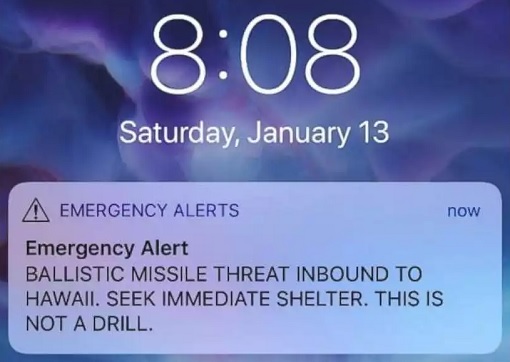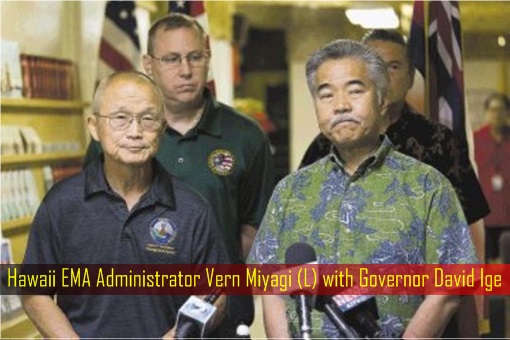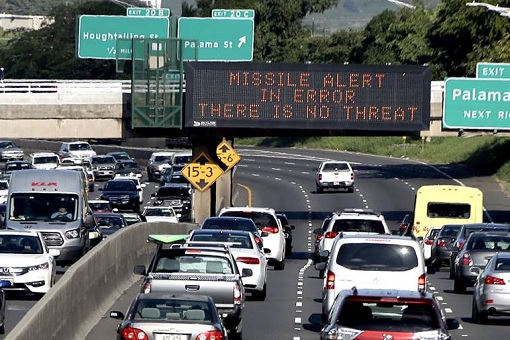In his New Year 2018 message to the United States, Kim Jong-un deliberately sent a nasty and provocative message to Donald Trump – “nuclear button is always on my desk”. Trump retaliated that he has a bigger nuclear button. There’s little doubt that the U.S. has a bigger stockpile of nuclear bombs and ICBMs (intercontinental ballistic missile) than the hermit kingdom.
But there’s something deadlier than bragging about having bigger and powerful buttons – pressing the wrong button. President Trump was speechless, and probably humiliated, as Hawaiians were thrown into a panic on Saturday morning after an emergency alert was mistakenly sent, warning them to “seek immediate shelter” from an incoming ballistic missile.
In what appears to be a huge embarrassing moment to the world superpower, the false warning was blasted out to television, radio as well as cell phones with an Armageddon message that reads – “BALLISTIC MISSILE THREAT INBOUND TO HAWAII. SEEK IMMEDIATE SHELTER. THIS IS NOT A DRILL.”

Television was having a busy day broadcasting – “The U.S. Pacific Command has detected a missile threat to Hawaii. A missile may impact on land or sea within minutes. This is not a drill. If you are indoors, stay indoors. If you are outdoors, seek immediate shelter in a building. Remain indoors well away from windows.”
The TV broadcast concluded – “If you are driving, pull safely to the side of the road and seek shelter in a building or lay on the floor. We will announce when the threat has ended. This is not a drill. Take immediate action measures.” It would take Hawaii authorities 38 minutes to send a second message confirming the false alarm.
Vern Miyagi, Administrator of Hawaii Emergency Management Agency (EMA), claimed at a news conference that while employees were changing shifts earlier in the day and doing a test of their ballistic missile prep checklist, the wrong button was pushed. It was the lapse which led to an uproar over how such an error – with potentially dangerous consequences – could occur.

Mr. Miyagi admitted that to trigger the alert, there is a two-step process involving only one employee – who both triggers the alarm, and also confirms it. Apparently the employee saw the screen that says – “Are you sure you want to do this?” – but confirmed the alert anyway, causing a widespread panic in the state after the apocalypse message appeared at about 8:07 a.m. local time.
It wasn’t until 38 minutes after the first warning – at 8:45 a.m. – that Hawaii’s EMA alerted mobile devices across the islands that initial alert was a false alarm. Apologizing for the screw-up blamed on human error, Mr. Miyagi said – “I deeply apologize for the trouble and the heartbreak that we caused today. We made a mistake.”
As an immediate solution, hopefully to prevent a repeat of such mistake, Mr. Miyagi said that there will now be a two-person rule implemented for sending test alerts and actual alerts. He also said that EMA will “hold off” on future tests of the system “until we get this squared away.” But that’s not the only problem resulted from the error.

Officials said they are investigating why some sirens on the island were triggered by the alert when they shouldn’t have been and why some people did not receive the alert to their phones although it was a false alarm. The FBI’s Strategic Information and Operations Center, Department of Homeland Security and Federal Emergency Management Agency are monitoring the situation.
Rep. Tulsi Gabbard, D-Hawaii, who also tweeted – “there is no incoming missile to Hawaii,” questioned how the mistake happened and why it took so long before it was corrected, adding that it triggered feelings of terror unnecessarily in a state with more than 1.4 million people. Sen. Brian Schatz, D-Hawaii, blasted the mistake as “totally inexcusable”.
After the major mistake, former Defence Secretary William Perry warned that there’s absolutely a possibility that a nuclear war could start by accident if proper safeguards aren’t taken. Mr. Perry, who served under former President Bill Clinton, tweeted – “The risk of accidental nuclear war is not hypothetical – accidents have happened in the past, and humans will err again.”

In an event of real missile strikes, they are first detected immediately by satellites that discern the infrared signature right off the launching pad. The U.S. Strategic and Pacific Commands is responsible for tracking, verification and analysis of such incoming missile attacks on American soil. Hawaii’s emergency management system, however, does not have this capability.
Hawaii relies on the U.S. military’s verification and analysis of missile threat. In the Hawaii incident, the U.S. Pacific Command was called and consulted only to confirm that there was no missile threat, and at 8:20 a.m., the state’s EMA followed up in a tweet: “NO missile threat to Hawaii.” That’s about 25 minutes before 1.4-million cell phones start receiving the good news.
The individual responsible for the incident would not be fired but instead would undergo retraining. President Donald Trump who was briefed on the incident was told that it was “purely a state exercise” by Hawaii. Still, the burning question remains – is U.S. really ready for a nuclear war, considering the system Americans have been told to rely upon failed miserably on Saturday?

Other Articles That May Interest You …
- Meet Zuma – The Missing $1 Billion Military Satellite That Pentagon Refuses To Explain
- Trump Has Bigger Nuclear Button Than Kim, But Putin Has The Biggest
- Chinese Flag Raised At Sri Lanka Port Raises Concern Of China Secret Naval Base
- Why Didn’t The U.S. Shoot Down Kim’s Missile? The Answer Is Quite Embarrassing
- Trump’s Declaration Of War – 20,000 South Koreans Could Die … Per Day
- China Has Spoken – If US-South Korea Strikes North Korea, We Will Defend Kim
- Declaration Of War! – U.S. Military Wants Control Over Ports In China & Russia
- Here Are Russia’s 3 Awesome Weapons Which The U.S. Is Absolutely Terrified Of

|
|
January 15th, 2018 by financetwitter
|


|

|

|

|

|

|




























Comments
Add your comment now.
Leave a Reply